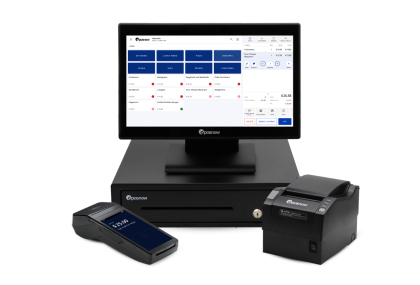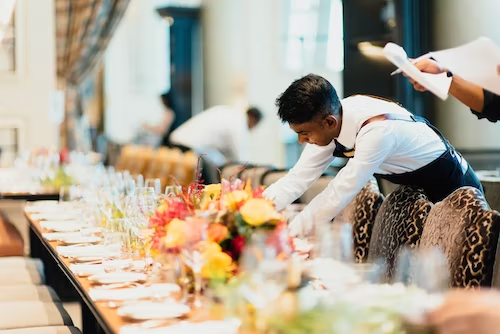Variable Costs For a Restaurant: What Are They?
When starting in the restaurant industry, planning and researching take a lot of time, but it helps to know what obstacles you'll face before achieving your dreams. If running a successful and profitable restaurant is your goal, you'll need to account for the expenses common to the food service industry.
If you know what costs are involved, you can work to reduce costs and stay prepared for when those bills begin to pile up. This article will outline the expenses for a restaurant so you can know what to expect and can handle your menu pricing accordingly.
What are fixed and variable costs?
The two categories of budget costs within a restaurant are fixed and variable. Examples of fixed costs for a restaurant are insurance, mortgage or rent payments, and license fees. The fixed costs of a restaurant do not vary, so managers will know exactly how much they will need to pay.
Managers often relish a fixed cost in restaurant situations as they are much easier to account for. Totaling those expenses that can be depended on not to change will go out of the business at a predicted time at the same amount.
Those expenses contrast with variable costs in a restaurant, of which there are many. Examples of variable expenses in a restaurant are labor, repairs, utility bills, taxes, and supplies.
The variable restaurant costs, as the name suggests, will change due to factors such as usage, business revenue, or the age and condition of the building. These variable costs restaurant managers and accountants need to track carefully to control finances and make business decisions, and therefore spend a lot more time calculating them.
Nevertheless, variable and fixed costs require careful attention when managing restaurant finances.
What are fixed costs in a restaurant?
Examples of fixed costs in a restaurant:
- Restaurant insurance
- License fees such as music licensing, food preparation licensing, etc.
- Rent or mortgage payments for the premises
- Specific fixed tax requirements
- Business loans
- Any staff that are on salaries
What are variable costs in a restaurant?
Examples of variable costs:
- Ingredients
- Delivery or travel/vehicle expenses
- Utility costs (gas, electricity, water)
- Card payment processing fees
- Repairs and building maintenance
- Labor costs

Epos Now send out monthly software updates and look to make new partnerships at every opportunity to ensure businesses have the best chance to create the perfect bespoke setup to suit any enterprise:
- Streamline your sales setup to shave time during transactions and satisfy customers
- Manage inventory through barcodes, categories or previous lists, with flexible stock control technology
- Choose from hundreds of dedicated apps with business tools for every part of trade
- Receive business advice whenever you need it to get the most out of your system with an expert support team
What to think about when paying the fixed cost of a restaurant
Since fixed costs can be calculated and do not change, they can take up different proportions of restaurant operating costs. The problem with fixed costs is that they will accrue even if the restaurant does not trade, open, or goes through a difficult period.
Conversely, if the restaurant experiences a successful period, fixed costs can become much less significant. Consequently, restaurant owners often worry about fixed costs a lot more during slow periods. Still, the lack of variation means they can often be accounted for on a long-term, annual basis, diminishing their impact during slow periods.
What to think about when paying the variable costs of a restaurant
Variable costs often require accounting on an individual basis. If the restaurant's oven breaks, the restaurant owner will not have predicted the cost of the tradespeople needed to fix the stove. The funds to pay for this need to be found and paid quickly, so variable costs often require emergency funds or even a short-term loan.
While miscellaneous expenses like equipment servicing can catch businesses out, the good fortune of most variable costs restaurant companies face is that they only rise in keeping with revenue.
For instance, if the restaurant runs an event or receives extra bookings, it may take on additional staff to help maintain reasonable service standards. While this means a higher wage bill, the wages have only risen because the business expects to make more money from customers.
Ingredients expenses follow a similar pattern. So long as the restaurant manages wastage and rotates ingredients as required, additional ingredients will only be necessary if the kitchen turns out more dishes. Nevertheless, the restaurant food cost varies with the menu, supply changes, efficiency of the staff, wastage, and many other factors.
What makes opening a restaurant expensive?
Most of the expenses involved in opening a restaurant are one-off payments. Others will be the first payments that will need to be repaid. The first fixed costs in a restaurant, such as rent and licensing, must be paid before opening. The first variable costs for a restaurant will similarly need to be put up, such as the first food costs.
But those payments don't make opening a restaurant expensive. Purchasing premises, if the business rents, will cost the same amount each month, but you will need to make a deposit that could be as much as $10,000+.
However, restaurant owners need to invest heavily in equipping the kitchen and purchasing furniture for guests and decorating to create a personality or restaurant brand your guests can enjoy. This may well be your most considerable expense, but it varies greatly depending on the kind of cuisine you intend to serve and the quality of the restaurant you'll be running.
The total opening costs most restaurants face will fall in the wide bracket between $175,000 and $750,000, with the prime costs of acquiring premises and equipment[1].
How can I lower opening restaurant costs?
How much does it cost to open a restaurant? Aspiring restauranteurs can reduce opening costs, but often at the expense of operating costs. Reducing expenses for a restaurant in this situation can be a question of paying later rather than sooner. The different methods of opening a restaurant might be:
- Franchising. A proven model from an existing restaurant company can speed up the process of opening and reduce some costs, but it also means giving away a large amount of control. However, opening a franchise for an existing restaurant can mean receiving financial assistance, or paying more, depending on the brand you're working with. Despite restaurant franchise costs, you'll likely receive some help, be it financial or advisory, if you choose to franchise.
- Renting a furnished restaurant. When searching for premises, you could look for a location that has previously been used as a restaurant and therefore has many of the furnishings and equipment you need. This can reduce initial expenses significantly as you'll have far fewer purchases still to make. The counterpoint to this is these initial savings will likely be paid for in higher rent.
- Crowdfunding. This method has grown in popularity in recent years as an alternative way of accessing finance. If your restaurant concept has traction in the local community, and you don't have all the finance to fully realize your dream, you can ask your future diners to provide a little extra help. While this may sound outlandish, there are many heartwarming stories of restaurants crowdfunding their way to opening day[2].
What day-to-day expenses do restaurants face?
The day-to-day expenses for a restaurant largely revolve around the products you sell (food and drink), utility expenses (energy for electrics, lighting, and gas stoves, as well as water), staffing, and legal expenses such as insurance and licenses.
Many of these were described earlier when discussing fixed and variable costs for a restaurant. But understanding how much each of these will cost often proves difficult. That's why most restaurants invest a lot of time and energy into anticipating expenses.
Keeping diners comfortable, for instance, comes at a significant expense. With energy bills rising, many restaurants are looking to economize on energy bills to limit the impact rising prices will have on their profit margins.
How does restaurant insurance work?
The cost of restaurant insurance varies depending on the extent of coverage you take out and the amount you're covered for. You might pay something in the region of $175 a month for coverage up to $1,000,000, which would mean in the event you were sued, and insurance premiums would cover any settlement up to a million dollars[3].
There are different types of restaurant insurance available to business owners, each with its own set of pros and cons. The most common type of restaurant insurance is general liability insurance, which covers the cost of damages if a customer is injured on the premises or if the restaurant's food causes illness. This type of coverage can be expensive, but it is vital for protecting the restaurant against potential lawsuits.
Another type of restaurant insurance is property insurance, which covers the cost of damage to the restaurant's building and contents in the event of a fire, storm, or other disasters. This coverage is important for protecting the restaurant's investment, but it can be expensive.
Restaurants can also purchase workers' compensation insurance, which covers the cost of medical treatment and lost wages for employees who are injured on the job.
States' requirements on the extent and kinds of insurance restaurants need do vary, so research on local laws will be necessary to conform to these requirements in your state.
What permits do restaurants need?
There are several permit regulations that restaurants need to obtain as legal permission for selling alcohol, food handling hosting events, playing music, as well as developing the building if desired. Some restaurant licenses and permit costs are optional, but some are necessary.
Liquor license
For example, in order to sell alcohol, restaurants need a liquor license from the state in which they are located. This license allows them to purchase and sell alcohol from licensed vendors. Such a license can cover certain kinds of alcohol; others can allow you to sell any and all forms of liquor.
Similarly, liquor licenses can last from 1 to 3 years, with renewals usually reduced from an initial fee starting at $3,000 for more limited liquor licenses[4].
Music permits
Restaurants may also need permits to host special events, such as live music performances. In some cases, a permit is required any time amplified sound is used or if you will make money from the recording. Other times, a permit is only required to play recorded music above a certain volume, which most restaurants will require to create an atmosphere.
Food handling
If your restaurant needs any one license, it's for food handling. Passing health and safety checks and obtaining the necessary food license will allow you to begin trading. These shouldn't cost any more than $100 or $150 but will likely involve completing a course to show that you and your staff are correctly informed on how to handle food safely for public consumption[5].
Zoning permission
For any construction or remodeling projects, restaurants will need to obtain the appropriate zoning permits from their local building department. This is to ensure that the work meets all safety and code requirements.
What labor costs can I expect?
Staffing expenses can be both fixed and variable depending on the hours you offer staff and whether you have staff on salaries or hourly wages. It can vary greatly depending on the type of restaurant you own. For example, a fast food restaurant will have lower labor costs than a fine dining establishment. In general, the labor cost for restaurant can be divided into two categories: front-of-house and back-of-house.
The front-of-house staff includes servers, bartenders, and hosts or hostesses. Labor costs for these positions in more upmarket establishments will be higher as they require experience and customer service skills. The back-of-house staff includes cooks, dishwashers, and prep cooks. Labor costs for these positions will be lower as they do not require the same customer service skills.

If you're running a fast food restaurant, it may be that you don't need a high level of skill requirements and can therefore afford to offer a similarly basic wage to both front and back-of-house staff.
Beyond the wage, both hourly employees and those on monthly salaries will expect certain employee benefits, such as holidays, which will need accounting. Many restaurant businesses rely more on hourly workers who will accumulate holiday pay as they work, so while this boosts your labor cost percentages, it will be a variable cost that needs to be factored in as you trade.
Minimize your wage bill using POS data
In order to keep the labor cost percentage of your expenses as minimal as possible, it is important to staff your restaurant appropriately. This means having the right number of employees for the amount of business you are doing. If you are busy, you will need to have more staff on hand in order to provide good customer service. However, if the business is slow, paying for unused labor can lead to losses for the business, as labor costs make up a significant portion of day-to-day operating expenses.
To maintain this balance, use your POS reports to understand which days of the week tend to be busier and which months are more lucrative. This allows you to adjust your staffing in anticipation of busier and weaker days.
How much does it cost to buy a POS?
Much like the restaurant prime costs, such as restaurant equipment, the POS industry has cost management options, allowing those short on capital to pay less upfront by paying slightly higher monthly fees.
But a good POS system can make a restaurant operation much more than it costs. Epos Now systems, for instance, save money by processing transactions quicker and more reliably and can have staff trained for use in as little as fifteen minutes. This helps reduce labor costs, boosts employee retention, and can improve sales volume by shortening queues.
Epos Now customers using a restaurant point of sale benefit from inventory management software that helps update and maintain stock levels in a timely manner, which then remain constant, updating in real-time as you make sales.
Make sure your restaurant benefits from a world-class POS
Whether its maintaining accurate menu prices or learning more about your business, Epos Now have all the tools you need to run the best restaurant in town with a restaurant POS to build your business:
- Gain every advantage with hundreds of apps and partnerships with the best software in every industry.
- Sell safely and speedily with the latest transaction technology.
- Use Epos Now Payments to incorporate card processing into your POS with a simpler, easier style.
- Manage your business stress-free with cloud technology that gives you instant access to the latest business data from anywhere in the world!
To find out more about Epos Now solutions, submit your details below and speak to a member of our expert team.
Join Epos Now for modifiable software and flexible hardware to suit any restaurant
trusted by over 40,000 businesses worldwide




